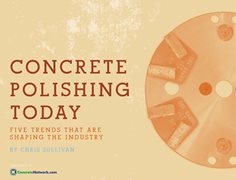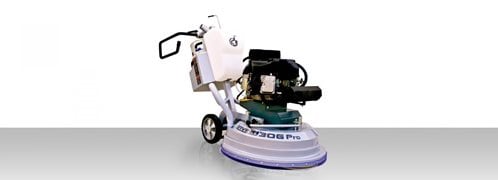- Concrete Polishing Equipment
- Get the Look - Polished Concrete Pictures
- How to Polish Concrete: Learn the basics and get a step-by-step overview
- Polished Concrete Preparation: How to clean, repair, and evaluate before polishing
- Concrete Polishing vs. Resurfacing
- Reviews of Concrete Polishing Equipment How to clean, repair, and evaluate the condition of concrete floors before polishing
- Tips on Using Polishing and Grinding Equipment
- Tips for Choosing Edge Grinders
- Selecting Dust-Collection Equipment
- Diamond Tooling: Tips for choosing the right type of diamond tooling and equipment
- Concrete Densifiers: An introduction to chemical hardeners and how they work to improve polished concrete
- 2023 Polishing Techniques: An online interview series featuring Bob Harris
Polished Concrete Design and Style Trends
The clean, simple industrial look is the prevailing design trend for both commercial and residential polished concrete floorsThis is an excerpt from the new e-book “Concrete Polishing Today,” part of a series of reports from ConcreteNetwork.com on trends and insights about decorative concrete applications.
Concrete Polishing Today

Discover five developing trends in concrete polishing from ConcreteNetwork.com’s new e-book. You’ll also get insights and guidance from veteran polishers that will help you stay profitable in today’s market.
Download Concrete Polishing Today (PDF)
As a whole, the polished concrete industry tends to be simplistic when it comes to design and style. The most popular color is natural gray concrete, with a vast majority of polished floors not utilizing any color or other design elements. “The reality is that a majority of the polished market is considered very minimalistic when it comes to colors and design,” says Bob Harris, owner of The Decorative Concrete Institute, Temple, Ga.
The clean and simple industrial look is a popular trend with both commercial and residential construction, and polished concrete fits nicely into that design mode. The ability to manipulate plain gray concrete to achieve various design elements is one of the benefits that makes polished concrete so versatile and adds to its popularity among designers and homeowners. Polished concrete can range from a paste polish, where the final color is uniform with no aggregate visible, all the way to a deep polish where large aggregate is exposed, closely resembling terrazzo.
“Most of our customers want a salt and pepper finish,” says Chris Raiser, manager of Extreme Polishing, a distribution outlet in Deerfield Beach, Fla., specializing in polished concrete equipment and chemicals. This type of finish is produced by removing a very thin top layer of the concrete during the initial grinding process to expose some of the sand aggregate. The exposed sand resembles salt and pepper and provides a nice color accent to the concrete without the addition of stains or dyes. Raiser also says they are seeing a trend where clients are switching to deep polished concrete to achieve the look of terrazzo at a lower cost.
Decorative optionsWhile coloring polished concrete is still an emerging trend, the vast color palette and endless design opportunities give installers of polished concrete floors many options to choose from. In fact, polished concrete has been one of the driving forces behind the growth in the popularity of concrete dyes. The smaller particle size and better solubility of a dye compared to a stain allows for deeper penetration and stronger, more vivid color development. Another benefit of dyes is that many are suspended in acetone or alcohol. These solvents have very low surface tension compared with water, which allows them to penetrate much deeper into the concrete and dry quickly. When the conditions are right, dyes can be a great way to create amazingly colorful polished floors.
Logo and stencil work is another area where polished concrete is seeing exciting growth. The smooth finish of polished concrete lends itself well to stencils, allowing for very intricate designs to be applied. Companies who see the value of polished concrete as a flooring option also see the benefit of having their company logo or other marketing message etched or colored into the concrete. “Occasionally we will find a client that wants to take the floor over the top with intricate saw designs or graphics, like engraving rivers into the floor or decorative stenciling,” says Harris. A real advantage of stencils is that the design is permanent and becomes part of the concrete. The logo or message takes on the luster and shine of the polished concrete, giving the effect that the design is in or below the concrete surface.
Related informationConcrete Dyes Expand the Color Palette of Concrete Stains
Stenciling Concrete Floors
Return to Concrete Polishing Today
 Polishing Diamonds
Options for hard, medium, and soft concrete.
Polishing Diamonds
Options for hard, medium, and soft concrete.
 CPS G-170 Electric
17" Floor Grinder 230 volt ($7,600)
CPS G-170 Electric
17" Floor Grinder 230 volt ($7,600)
 Propane Concrete Polisher
Concrete Polishing HQ
Propane Concrete Polisher
Concrete Polishing HQ
 Scanmaskin Diamond Tools
A wide variety of different sizes and hardness
Scanmaskin Diamond Tools
A wide variety of different sizes and hardness
 Lythic Densifier XL
1 Gallon & 5 Gallon sizes
Lythic Densifier XL
1 Gallon & 5 Gallon sizes




